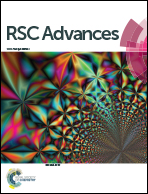Effect of calcination temperature and Ti substitution on optical properties of (Fe,Cr)2O3 cool black pigment prepared by spray pyrolysis
Abstract
Near-infrared (NIR) reflective Fe1.5Cr0.5O3 black pigments were synthesized by spray pyrolysis, and the effect of calcination temperature and Ti substitution on the optical properties were investigated. As the calcination temperature increased from 500 °C to 800 °C, the prepared Fe1.5Cr0.5O3 powder had α-Fe2O3 phase without any impurities and the NIR reflectance steadily increased. On the otherhand, the smallest chroma value was observed at 700 °C. Therefore, in terms of achieving high NIR reflectance with keeping good blackness, the optimal calcination temperature was determined to be 700 °C. Substitution of Ti corresponding to 5–15% of the total metal ions in Fe1.5Cr0.5O3 largely affected the NIR reflectance and chroma value, but there was no significant change in the optical band gap. Ti substitution of 5 mol% could further improve the NIR reflectance of the Fe1.5Cr0.5 black pigment without significant loss of blackness, but above 10% or higher the NIR reflectance largely decreased due to the loss of crystallinity. Resultantly, Fe1.4Cr0.5Ti0.1O3+δ (5% Ti substituted black pigment) was confirmed to have improved heat-shielding performance compared to Fe1.5Cr0.5O3 in a temperature rise test under near-infrared illumination.



 Please wait while we load your content...
Please wait while we load your content...